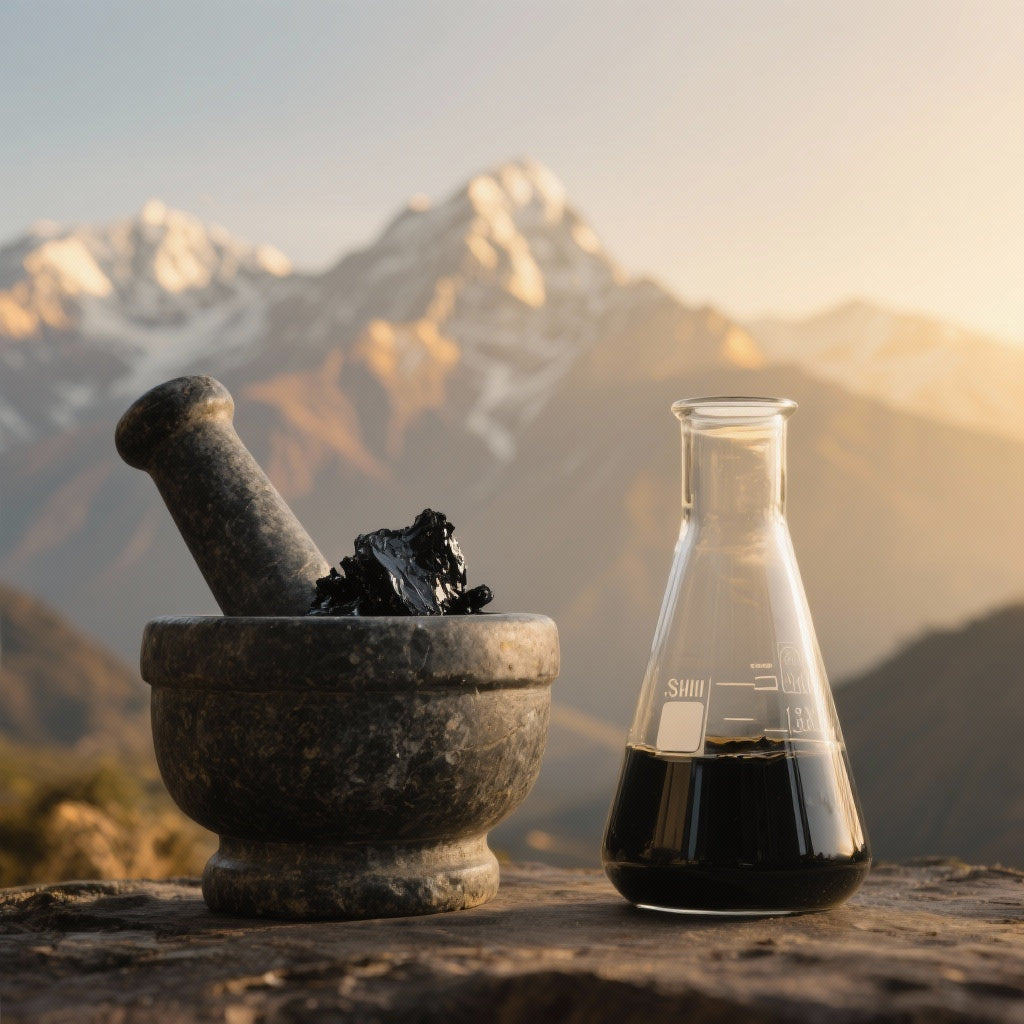Tantric Alchemy vs. Modern Preparation: How to Preserve the Essence of Shilajit
Shilajit, often called "the tears of the Himalayas" or the "conqueror of the mountains," is much more than just a superfood. It is a primordial substance, a concentration of centuries of plant decomposition, rich in fulvic acid and over 84 essential minerals. But in our modern quest for wellness, a crucial question arises: Is the Shilajit we consume today the same as that revered by yogis and tantric sages millennia ago?
The race for efficiency and mass production has given rise to rapid, industrial preparation methods. These techniques, while profitable, risk stripping this precious resin of its soul, its life force, its prana . This article explores the fundamental difference between ancient Tantric alchemy and modern processes, and provides you with the keys to choosing a Shilajit that nourishes not only your body, but also your spirit.
Tantric Alchemy: The Wisdom of the Ancients in the Service of Purity
In Vedic and Tantric traditions, the purification of Shilajit was not an industrial process, but a sacred ritual. It was a true alchemy aimed at amplifying the substance's energy while eliminating impurities. These ancient methods are slow, deliberate, and deeply respectful of nature.
The "Surya Tapi" process: The Patience of the Sun
The most revered method is known as Surya Tapi , which literally means "sun-dried." Raw Shilajit, hand-harvested from the rocky mountain slopes, is dissolved in pure spring water. The solution is then filtered through layers of cloth to remove physical debris such as soil and pebbles. Finally, it is left to dry on large trays under the high-altitude sun.
This process can take weeks, even months. The sun doesn't just provide heat; its light spectrum and energy nourish and transform the resin. This slow, gentle exposure allows the water to evaporate naturally, concentrating the minerals and bioactive compounds without the thermal shock of artificial heat.
"Nature does not hurry, and yet everything is accomplished. Purification by the sun honors this principle, infusing the Shilajit with cosmic life energy, or prana, which is the very essence of healing." - Ayurvedic Proverb
Intention and Energy: The Role of Mantras
Tantric alchemy transcends the physical. During the purification process, specific mantras were chanted. According to Vedic science, these sacred sound vibrations have the power to restructure matter on a subtle level, amplify the healing properties of the substance, and neutralize any negative energy. This was an acknowledgment that healing is a holistic phenomenon, where energy and intention are as important as chemical composition.
Modern Preparation: Effectiveness at What Price?
Faced with growing global demand, the industry has developed methods to radically accelerate Shilajit production. While these techniques make the product more accessible, they raise legitimate questions about preserving its integrity.
Solvent Extraction: A Risky Shortcut
To quickly dissolve raw Shilajit, some producers use chemical solvents such as hexane or ethanol. Although these substances are supposed to be removed from the final product, there is still a risk of residue. More importantly, these harsh chemicals can alter the delicate molecular structure of Shilajit's most valuable compounds, including Dibenzo-α-Pyrones (DBP), which are essential for its anti-aging and energizing benefits.
High Temperature Pasteurization: Safety or Sacrifice?
To ensure microbiological safety and accelerate the drying process, many manufacturers boil or heat the Shilajit solution to very high temperatures. This intense heat can have devastating consequences:
- Enzyme destruction: The beneficial enzymes naturally present in Shilajit are sensitive to heat and are destroyed, thus reducing its bioavailability.
- Fulvic acid degradation: The complex structure of fulvic acid, the main nutrient carrier of Shilajit, can be damaged, decreasing its ability to transport minerals to our cells.
- Loss of volatile compounds: Subtle aromas and compounds that contribute to the overall therapeutic profile are simply evaporated.
The final product may be sterile and standardized, but it is often energetically "dead", far from the vibrant life-giving substance known to the ancients.
The Fundamental Conflict: Why Method Matters More Than Anything
The divergence between these two approaches is not merely technical, but philosophical. On one hand, a holistic view considers Shilajit as a living entity. On the other, a reductionist view sees it as a simple collection of molecules to be extracted.
Shilajit treated with high temperatures and chemicals may still show the presence of minerals in a laboratory analysis. However, this analysis reveals nothing about the state of these minerals, their synergy, or the substance's energetic footprint. It's like comparing a fresh, ripe fruit to a canned, boiled, and sweetened version. Both may contain vitamins, but their impact on the body is radically different.
Key statistic: Studies suggest that bioactive compounds such as DBP and DBP-Chromoproteins (DCP) are extremely sensitive to heat. Heat treatment above 60°C can reduce their effectiveness by more than 50%.
Choosing Shilajit purified using traditional methods means choosing a product that has retained its innate biological intelligence. It means trusting in the wisdom of nature rather than the brute force of industry. Discover lifestyle tips to integrate this philosophy into your daily life.
How to Recognize an Authentic and Preserved Shilajit?
As an informed consumer, you have the power to choose. Here is a checklist to help you identify a high-quality Shilajit that respects the heritage of this sacred substance.
- Brand Transparency: Does the supplier clearly explain their purification method? Be wary of brands that remain vague. Look for terms like "low-temperature purification," "sun-dried," or "traditional method."
- Third-Party Laboratory Testing: A reputable brand will provide recent and independent Certificates of Analysis (CoAs). These should confirm not only the fulvic acid and mineral content, but also the absence of heavy metals (lead, arsenic, mercury) and microbial contaminants.
-
Physical Properties: Genuine Shilajit has unique characteristics.
- Texture: It should be a thick resin. It becomes sticky and malleable when warmed in the hand, and hard and brittle when cooled.
- Solubility: It should dissolve almost completely in hot water, creating an amber or reddish solution, without leaving any granular residue.
- Smell and Taste: Expect a strong, earthy, smoky aroma and a bitter, powerful taste. A tasteless Shilajit or one with a chemical odor is a red flag.
- Geographical Source: The most renowned Shilajit comes from the highest altitudes of the Himalayas, Altai or Caucasus, where pollution is minimal and ancient plant biomass is richest.
Incorporating Shilajit into your routine can be a pleasure. Explore our creative recipes to discover how to use it beyond simply taking it with water.











